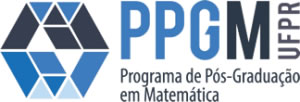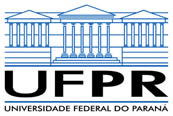Organização: Prof. Dr. Leonardo Silva de Lima e Prof. Dr. Elías Alfredo Gudiño Rojas
Evento Online
Período do Evento: 10 e 11 de março de 2022.
Período de inscrições: de 17/02 a 08/03/2022.
Contato: leonardo.delima@ufpr.br
Programação
10 de março de 2022 |
|||
| Horário | Palestrante | Título | Abstract |
| 9h00 às 10h00 | Carlos Hoppen (Instituto de Matemática e Estatística, UFRGS) | Teoria Espectral dos Grafos – Resultados, Pesquisa e Aplicações | Os autovalores e autovetores de matrizes associadas a grafos estão relacionados a muitas das suas propriedades topológicas. O crescente interesse nessa conexão levou ao surgimento da Teoria Espectral dos Grafos. Em uma palestra de caráter introdutório, apresentarei resultados clássicos, aplicações e direções de pesquisa nessa área. |
| 10h10 às 11h10 | Maicon Ribeiro Correa (UNICAMP) | On the accuracy of finite element approximations of elliptic problems with heterogeneous coefficients | The development of accurate and stable finite element methods for elliptic problems is related to the choice of the main unknowns of the problem and the respective finite-dimensional subspaces for their approximation. Some classical examples of unknowns/problems are the displacement and the stress tensor in the linear elasticity and the flux and the pressure in the Darcy problem. The primal field (displacement or pressure) can be approximated by using different Finite Element methods, such as the classical H1(Omega)-conforming Galerkin, Primal-Hybrid Formulations, and Discontinuous Galerkin Methods. In this case, the evaluation of the dual field (stress or velocity) demands a post-processing strategy, which uses a constitutive equation. The post-processing can be local or can be evaluated by setting a new problem in patches of elements or the whole domain. These techniques aim to provide dual fields with continuous normal components between adjacent elements and good mass conservation properties. In this work, we investigate the accuracy of different finite element post-processing strategies in the approximation of dual fields in elliptic problems such as the Darcy velocity in porous media flow and the stress tensor field in the linear elasticity problem, with special attention to problems with highly heterogeneous coefficients. This is a Joint work with Giovanni Taraschi, Alisson S. Pinto and Cristiane O. Faria. |
| 14h00 às 15h00 | Aida Abiad (Department of Mathematics and Computing Science, Eindhoven University of Technology, Eindhoven, The Netherlands) | Optimization of eigenvalue bounds for the independence and chromatic number of graph powers | In this talk, we will discuss the main spectral techniques to obtain eigenvalue bounds for the k-independence number and the k-distance chromatic number of a graph, as well as how to optimize such eigenvalue bounds. Some of the previous bounds known in the literature follow as a corollary of our main results. Some infinite families of graphs where the new bounds are tight are also presented. |
| 15h10 às 16h10 | Giuseppe Romanazzi (UNICAMP) | Mathematical models for Breach Formation in Earth Embankment Dams |
After an overview of breach formation in embankment dams, we present different mathematical models that are used to predict the formation of breach in earthen embankments. Particular attention will be focused on the “”physical”” models that use numerical methods to simulate and predict the breach formation. The strengths and weaknesses of the models are discussed. |
11 de março de 2022 |
|||
| Horário | Palestrante | Título | Abstract |
| 9h00 às 10h00 | Adilson Elias Xavier (UFRJ) | Hyperbolic Smoothing Method: A Novel Approach for Solving Clustering Problems | Clique aqui para acessar |
| 10h10 às 11h10 | Grigori Chapiro (UFF) | Foam flow in porous media is non-Newtonian, or isn’t it?
Mathematical aspects of the modeling. |
In this talk, I will present some recent theoretical results aiming at the non-Newtonian behavior of the foam flow in porous media. We will briefly discuss some results obtained using Uncertainty Quantification, Sensitivity Analysis [2], Traveling Waves, and Conservation Laws [1].
Acknowledgments: The current work was conducted in association with the R&D project ANP nº 20715-9, “Modelagem matemática e computacional de injeção de espuma usada em recuperação avançada de petróleo” (UFJF/Shell Brazil/ANP). Shell Brazil funds it in accordance with ANP’s R&D regulations under the Research, Development, and Innovation Investment Commitment. This project is carried out in partnership with Petrobras. References: |
| 14h00 às 15h00 | Juliana Gomes da Silva (UFPR) | Algoritmos de Lagrangiano aumentado aplicados ao problema de alocação de recursos não linear contínuo | Propomos uma classe de algoritmos para resolver o problema não linear contínuo de alocação de recursos. Esse problema é conhecido por sua diversificada gama de aplicações e nós o resolvemos usando uma abordagem híbrida, combinamos o método de Lagrangiano aumentado com o método de Newton para resolver os subproblemas gerados pelo algoritmo. A maioria dos trabalhos desenvolvidos nessa área trata de problemas quadráticos separáveis. Nossa proposta é mais geral no sentido que os problemas podem ser não quadráticos e não separáveis. Apresentamos e discutimos as propriedades de convergência para o método proposto e mostramos aplicações numéricas ilustrando sua competitividade e robustez. |
| 15h10 às 16h10 | Julia Silva Borges (UFSCAR) | Modelagem Numérica da Dispersão de Medicamentos em Polímeros Viscoelásticos | Plataformas poliméricas são comumente utilizadas para a dispersão de medicamentos uma vez que tal processo pode ser otimizado. Consideramos um modelo que caracteriza a entrada do lı́quido solvente na plataforma polimérica, a dissolução e difusão do fármaco. Tal modelo consiste em um sistema Integro-Diferencial e encontramos soluções numéricas aproximadas a partir do Método de Diferenças Finitas. Simulações numéricas que ilustram os resultados obtidos serão apresentadas bem como estimativas teóricas de estabilidade e ordem de erro para concentração de solvente. |

